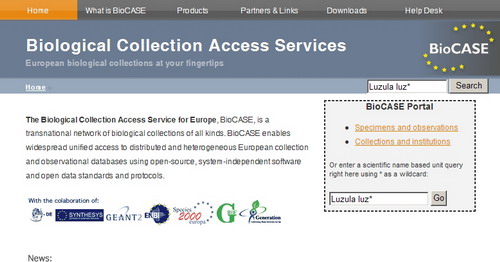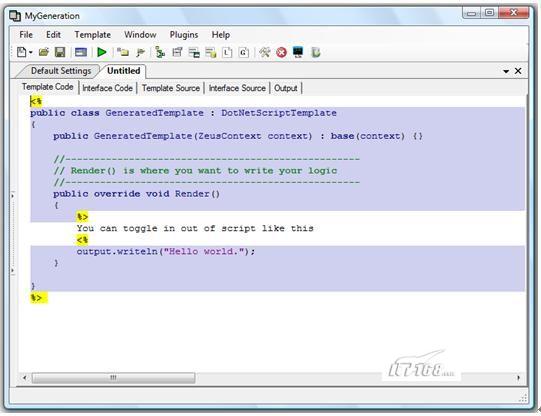
BioGeomancer项目是一个世界范围内的自然历史采集和地理空间信息系统专家合作的项目。
该项目的基本目标是尽可能的对生物多样性数据在空间作图方面的数据数量和质量通过保证,并且使这些数据都能够以空间分布图的方式呈现给用户,为科学研究、计划、保护和管理提供决策依据。

BioGeomancer项目是一个世界范围内的自然历史采集和地理空间信息系统专家合作的项目。
该项目的基本目标是尽可能的对生物多样性数据在空间作图方面的数据数量和质量通过保证,并且使这些数据都能够以空间分布图的方式呈现给用户,为科学研究、计划、保护和管理提供决策依据。

BioCASE是一个跨国性的生物学采集网络体系。它使用开源、系统独立的软件和数据标准来整合分布式和异构性的采集和观测数据的数据库系统,并给用户提供统一的网络服务。它与一些的项目和组织保持紧密的合作伙伴关系。
BioGeomancer Worldwide collaboration of natural history and geospatial data experts
ENBI European Network for Biodiversity Information, Jan. 2003 – Dec. 2005
ENHSIN European Natural History Spcecimen Information Network, Jan. 2000 – March 2003
EuroBioBank European network of DNA, cell and tissue banks for rare diseases
GBIF European Mirror Mirroring and replication of GBIF data services at the BGBM
GBIF The Global Biodiversity Information Facility
Géant2 the next generation of the multi-gigabit pan-European research network
IPGRI the International Plant Genetic Resources Institute
Ravns Resources Available in Natural Sciences
Seek The Science Environment for Ecological Knowledge
Species2000 europa (EuroCat, Feb. 2003 – Jan.. 2006)
Species2000 Catalogue of Life Programme
Included file ‘JB/setup’ not found in _includes directory

The Basics of Biodiversity Informatics
Biodiversity informatics, an emerging field, is the study of information related to the science of biodiversity and linking this information with other databases that may be geospatial, biological, and non-biological. Biodiversity informatics can refer to the creation of information related to biological diversity, as well as the analysis and understanding of this information. Information management tools are used in biodiversity informatics to manage all data. Biodiversity informatics databases may include information relating to an organism or organism related information such as distribution, conservation data, natural history, and molecular information. The goal of biodiversity informatics is to capture information related to biodiversity, and to analyze, provide, and store this data.
Biodiversity, or biological diversity, is the variation of lifeforms, including flora and fauna, on the planet. Biodiversity can be examined within a specific ecological region or biome. An important aspect of biodiversity informatics is to synthesize and improve protective measures that will improve or safeguard the biodiversity of a region.
The University of Michigan describes biodiversity informatics, or BDI, as an emerging interdisciplinary science that uses information technology tools to make information about biodiversity and ecosystems available for scientific researchers and for society in general. Biodiversity informatics can be seen as driven by a combination of factors, including the issue of biodiversity and ecosystems, the data and organization of data, and the tools and methods used to understand the data.
Biodiversity informatics is often at the organism level, focusing on individual organisms and populations, but may also be at the molecular level. The Human Genome Project is a famous example of a biodiversity informatics research project. This project works at the molecular level and provides information that may be shared and used across a number of disciplines. Biodiversity informatics is relevant and useful to many fields, including behavioral sciences, evolutionary biology, population biology, molecular biology, and others. Standards have been created and are still being developed for the formal exchange of biodiversity informatics data across the world and protocols for methods of data integration and management.
Biodiversity Informatics Resources That You Can Use
The following resources are web sites that include databases of biodiversity informatics terms, journal articles, and information on advances in the field of biodiversity informatics.
http://jbi.nhm.ku.edu/index.php/jbi. This link takes you to an electronic journal that focuses on the field of biodiversity informatics. Issues of the journal can be browsed going back to the year 2003, and you can search by author, title, or issue number.
http://circa.gbif.net (PDF) Here is an article titled Biodiversity Informatics: The Challenge of Rapid Development, Large Databases, and Complex Data.
http://www.calacademy.org This article gives a thorough overview of biodiversity informatics, focusing on taxonomy information. A number of links to resources and biodiversity informatics projects is also provided.
http://www.findarticles.com This article provides a comparison of biodiversity informatics and neuroinformatics.
http://www.nscalliance.org/bioinformatics/glossary.asp This web site provides a glossary of terms related to biodiversity informatics. This is a great resource to familiarize yourself with the field of biodiversity informatics, or to clear up some confusion with a term or acronym you may have encountered in relation to biodiversity informatics. For example, at this web site you can discover that BCIS refers to the Biodiversity Conservation Information System, a global partnership of conservation organizations that use Internet technology to provide access to the most current knowledge about biodiversity.
http://specifysoftware.org/Informatics. This link will take you to the Biodiversity Information Center Informatics with the University of Kansas Natural History Museum , where you can learn projects that link some of the world's natural history collections into virtual databases.
This emerging field is that will certainly be something that becomes more intriguing and applicable in the future.
原文链接:http://www.virtualinformatics.com/content/Biodiversity_informatics.htm

代码如下:
using System;
using System.Collections.Generic;
using System.Linq;
using System.Web;
using System.Web.UI;
using System.Web.UI.WebControls;
using System.Xml;
using System.Xml.Schema;
public partial class Default4 : System.Web.UI.Page
{
protected void Page_Load(object sender, EventArgs e)
{
string xmlFilePath = Request.PhysicalApplicationPath + @"App_Data\Authors.xml";
XmlDocument xmlAuthors = new XmlDocument();
Response.ContentType = "text/xml";
try
{
xmlAuthors.PreserveWhitespace = true;
xmlAuthors.Load(xmlFilePath);
Response.Write(xmlAuthors.InnerXml);
}
catch (XmlException xmlEx)
{
Response.Write("XML文件处理错误:" + xmlEx.Message);
}
catch (Exception ex)
{
Response.Write("Exception:" + ex.Message);
}
}
}

Snippet Compiler
Snippet Compiler是一个基于 Windows 的小型应用程序,你可以通过它来编写、编译和运行代码。如果你具有较小的代码段,并且你不想创建完整的 Visual Studio .NET 项目(以及该项目附带的所有文件),则该工具会很有用。现在Snippet Compiler已经支持.NET Framework 3.5,最新版本为Snippet Compiler Live 2008 Ultimate Edition for Developers (Alpha),如下图所示:

官方主页:http://www.sliver.com/dotnet/SnippetCompiler/
Microsoft Source Analysis for C#
Microsoft Source Analysis for C#是一款C#(不支持VB.NET)代码规范检查工具,前身是微软内部代码规范检查和代码格式强制工具StyleCop,目的是帮助项目团队执行一系列常用的源代码格式规范,它会根据预定义的C#代码格式的最佳实践进行检查,与FxCop不同的是它直接对源代码进行检查,且并不提供灵活的规则设置,强制开发者使用相同的习惯进行C#代码的编写。如下图所示:
官方主页:http://www.roland-weigelt.de/ghostdoc/
Sandcastle
Sandcastle是微软发布的一个帮助文档生成工具,它通过反射程序集中的源代码和添加代码到中的XML注释来创建专业级别的帮助文档。Sandcastle于2006年推出,它的面世也使得曾经列入.NET开发必备十大工具之一的文档生成工具NDoc的作者Kevin Downs在2006年7月宣告不再投入NDoc Open Source Project的开发。生成的文档效果如下图所示:





亚利桑那大学的生物多样性信息小组最近得到美国BIO5 Institute项目的支持。开发了基于物种、标本数据的搜索引擎和作图工具。
The Biodiversity Informatics Initiative is aimed at developing informatics infrastructure centered on the UA’s outstanding natural history collections, which house hundreds of thousands of biological specimens from around the southwest US and Mexico. By establishing a common underlying database architecture for all collections, setting up linkages to external resources, and providing for public access to all its products, the initiative aims to foster research in broad areas of biological sciences, ranging from systematics, ecology and global change biology, to comparative genomics and molecular biology.
Currently, our search engine and mapping tools provide access to specimens representing nearly 18,000 species of plants and vertebrates.
We are also developing tools to map Arizona’s biodiversity hotspots. For a preliminary view of plant species richness in the state, see ‘Summarized diversity maps’ on the Diversity Mapper page.
The Initiative is funded by the UA’s Bio5 Institute, College of Science, and College of Agriculture and Life Science.
1. 使用较少的HTTP请求
2. 合并文件:尽量将所有的脚本文件或者是CSS样式表文件合并到一个文件
3. 将网页背景图片尽量合并为一张图片文件
4. 使用CSS的’背景图’片和’图片位置属性’(CSS background-image and background-position)进行设置
5. 文件的大小: 减少文件数量, 对文件进行压缩, 将CSS文件放置在文件顶部,JS文件放在底部
详细的检查网页效率和方法参考: css聊吧
ObjectDataSource控件提供了两种方法对绑定到控件(比如GridView)的数据进行分页和排序:
通过用户界面进行分页,优点是容易设置,缺点是当数据量大时执行效率较低; 实现方法:
对GridView控件使用正确的数据源,比如:DataSet, Collection, DataTable或者DataView,但不能使用DataReader 在页面设置GridView控件分分页属性为True。AllowPaging=“True”
通过设置ObjectDataSource的分页,优点是数据量大时执行效率较高,特别是如果配合Caching能极大的提高以数据驱动为主的网络应用程序的效率。 ObjectDataSource数据源的分页可以在类Class, 存储过程, LINQ to SQL查询中实现,下面以LINQ to SQL,Northwind数据库的Product表为例子来说明用法:
实例网站的文档结构如下图:
!图1
‘’‘ using System; using System.Collections.Generic; using System.Linq; using System.Data.Linq; using System.Web;
///
{
public ProductsLINQPaging()
{
//
// TODO: Add constructor logic here
//
‘’’

世界上有这样一些地区,它们的面积仅占地球陆地表面积的1.4%,但它们所拥有的生物物种占世界生物物种的60%。国际保护联盟已确定这些地区属于世界生物多样性的“热点地区”(Hotspot),需要得到优先保护。不止水库丰富的植物和动物的生活,不过,热点正处于高危地区已显着退化的人类。到去年底的第一个十年二十一世纪,这些极为重要的自然区,可以,但记忆。不过,根据作者生物学家罗素mittermeier ,一个相对小数额的资本,可以帮助保护相结合的面积大小的阿拉斯加和有戏剧性的效果,在保护生物多样性。一些这些热点包括热带安第斯山脉,中美洲国家的森林,东南亚和菲律宾,歌连臣角地区,南非和地中海盆地。
作为一本书,热点是一个有份量的一瞥在世界上处于危险之中。彩色摄影所喜欢的艺术,沃尔夫和其他方面是一流的-从字面上眼开放:贺岁片的航空照片的贝齐布卡河在马达加斯加,举例来说,显示大规模的侵蚀是明显的,甚至从外层空间。每25热点地区在世界各地,是伴随着文字,科学的图表,地图,以及大量的照片,展示双方的破坏和奇妙的自然世界。

由美国亚利桑那州立大学大学的Quentin D. Wheeler教授主笔的新书-The new taxonomy出版了。以下书对全书内容的介绍:
Initiatives reinventing taxonomy for the Internet generation are leading to a dramatic resurgence in this once declining discipline. Looking at the effort of several groups, especially the Global Bioinformation Diversity Facility, to catalog the world's biodiversity and make it accessible via databases, this work discusses the future of descriptive taxonomy.
The book covers such technology as DNA barcoding and its applications, computer-assisted species identification, digital morphology, and E-typification. It also provides insight into effective ways of organizing taxonomic information, and discusses what benefits can be leveraged from a rapid growth of taxonomic knowledge.